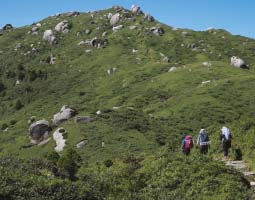Home > Highlighting JAPAN > Highlighting Japan November 2018 > Living In Tune with Nature: Japan's Connection to Wood
Highlighting JAPAN


Yakushima: Island of Thousand-Year-Old Cedars
The normal lifespan for a cedar tree is reportedly a little more than five hundred years, but Yakushima’s Yakusugi have flourished for over ten centuries, and the islanders have revered these cedar giants as sacred since ancient times. Registered as a Natural World Heritage Site in 1993, the remote island is a popular destination for tourists.
Yakushima lies sixty kilometers south of Cape Sata, the southernmost point on Kyushu. Forest covers ninety percent of the island, and Kyushu’s tallest peak, Miyanouradake (1,936 meters) is part of a mountain range nicknamed the “Alps of the Sea.” Yakushima’s climate ranges from subtropical to subarctic, and is home to a diverse array of plant life. Winter caps the mountaintops with snow while tropical fish swim in its coastal waters.
Yakusugi cedars are over a thousand years old, and primarily grow in the virgin forests between altitudes of 500 to 1,600 meters. A cedar tree normally lives for about five centuries; oddly, the reason these cedars live so long is the harsh environment they face. When Yakushima rose above the sea fourteen million years ago, its granite surface offered little sustenance. The altitude where Yakusugi are found is exposed to the influence of ocean currents, wind and typhoons. In this unforgiving environment of nutrient-poor soil, the cedars built up the sap that makes them resistant to rot and extends their lifespan, gradually becoming giants.
“Yakushima’s mountain recesses were a place of faith for the people. Naturally the great trees that stood on the mountains of the gods were also considered sacred,” says Junichi Hidaka, secretary of the Yakushima Tourism Association. The island dwellers revered the Yakusugi and protected them.
According to Hidaka, with forest expertise gained through forty-five years as a volunteer guide and mountain rescue team member, a cut stump in the forest makes you sense the passage of centuries and shows that cedars were once harvested long ago. Old records indicate that building materials for Hokoji Temple in Kyoto—built on behalf of Toyotomi Hideyoshi and completed in 1595—were procured from Yakushima. The records note that his vassal, Lord Shimazu of Satsuma Province, went to the island to survey it and took control of it. A Confucian scholar from Yakushima who served Lord Shimazu, Tomarijochiku, suggested using cedar planks to pay the land tax. He also taught the islanders how to recognize the sacred trees so they wouldn’t overharvest them, and to plant a new seedling after cutting one down.
When the Meiji Period (1868-1912) began, Yakushima’s forests became national property. People had once carried the wood down the mountain on their backs; now a small train transported it. In the 1960s, large-scale logging accelerated with the wave of high economic growth.
At the same time, protecting the Yakusugi became a priority. The virgin forest was designated a natural monument in 1924, a special natural monument in 1954, and was made a national park in 1964. The island’s Yakushima Environmental Protection Group, formed in 1972, later led to all logging being prohibited.
Yakushima became Japan’s first natural World Heritage Site in 1993, and 2018 marks the twenty-fifth anniversary of that event. The island subsequently received significant attention, and the number of visitors on the Jomon-Sugi mountain hike exploded, causing worries of environmental degradation. But Hidaka notes this also had some positive effects. “The island’s young people stopped saying ‘I’m from Kyushu,’ and now say ‘I’m from Yakushima’ with pride.
“The reason so many trees are scarred with grooves is that they were tested by wind and rain for so long,” he continues. “These trees with clefts survived because they were not considered worth harvesting. Now these Yakusugi are gaining attention as ‘heroes of the forest.’ They teach us how to live in the environment we find ourselves in. When I talk about this while guiding tours, guests often shed tears.”
Many Natural World Heritage Sites have never been touched, but the Yakushima islanders harvested just enough trees for their needs and planted new ones in their place. Those trees planted during the Edo Period (1603-1867) are now considered young cedars—under a thousand years old—and the islanders will continue to protect them as they grow into future Yakusugi.
© 2009 Cabinet Office, Government of Japan








